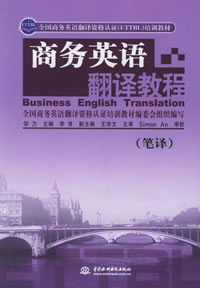英文法律文书简明教程(八) 逗号
作者:古龙 2009-07-04




语际翻译公司 转载请注明https://www.scientrans.com
∗本栏目部分文章内容来自互联网,部分已经过本站编辑和整理,如有版权事宜请联系Email/MSN jesczhao@hotmail.com
Commas
逗号的用法是正确运用标点过程中最复杂,最容易产生误解的问题之一。在一些情形中,存在着被广泛接受的用法。然而在另一些情况下,却有不只一种用法。学生常常认为,担心标点的用法有点可笑:毕竟,法律分析才是最重要的呀。但是,假如一个人申请一份工作或向上级提交书面报告,没有什么会比忽视标点运用基本规则更容易给人留下负面印象的了。毕竟,一位高级律师是决不会愿意去更正一位初级律师的逗号的用法的。
Comma usage is one of the most complex, and most misunderstood, questions of proper punctuation. In some cases there are widely accepted rules governing comma usage; in a few cases, there is more than one acceptable approach. Students often think it's silly to worry about things such as punctuation: after all, isn't the legal analysis what really counts? However, when one applies for a job or submits written work to a supervisor, nothing will leave a more negative impression than ignorance of the basic rules of punctuation. After all, the last thing a senior attorney wants to do is correct a junior attorney's comma usage.
1.
当你用一个短语或从属分句开始一个句子,并随后引入一个独立分句时,用逗号分隔。
When you begin a sentence with a phrase or dependent clause to introduce a subsequent independent clause, separate the clauses with a comma.
Incorrect: After many years as a criminal prosecutor she ascended to the bench.
Correct: After many years as a criminal prosecutor, she ascended to the bench.
Incorrect: Because the witness was unavailable the judge allowed the introduction of the testimony pursuant to an exception to the hearsay rule.
Correct: Because the witness was unavailable, the judge allowed the introduction of the testimony pursuant to an exception to the hearsay rule.
2. 用逗号分隔非限制性从句,但不要用逗号分隔非限制性从句。
非限制性从句告诉你关于句子主语的某些事情,但并不对其含义进行限定;相反,限制性从句对主语的含义进行限定。
Use commas to set off a nonrestrictive clause in the middle of a sentence, but not to set off a restrictive clause. Nonrestrictive clauses tell you something about the subject of a sentence, but they do not limit, or restrict, the meaning. Restrictive clauses, on the other hand, limit the possible meaning of the subject.
ompare the following examples.
Correct Restrictive Use:
The suspect in the lineup who has red hair committed the crime.
Note how the subject "suspect" in this sentence is restricted in two ways: we know that this suspect is both in the lineup and has red hair. As a result, we know that the other suspects, who are not in the lineup, could not have committed the crime. Moreover, of those suspects in the lineup, we know that the one suspect in the lineup with red hair committed the crime. If there were more than one suspect in the lineup with red hair, the above usage would be incorrect because it implies a different meaning.
Correct Nonrestrictive Use:
The suspect in the lineup, who owns a red car, committed the crime.
In this example, the restrictive clause "in the lineup" tells us that of all possible suspects in the world, the one who committed the crime is in the lineup. However, while the nonrestrictive clause "who owns a red car" tells us something about the suspect, it does not foreclose the possibility that there are several different suspects in the lineup with red cars. The car color may tell us something useful, but it does not restrict us to only one possibility.
3.用两个逗号来分隔同位语或插入语。同位语是对它所跟随的名词进行描述的单词或短语,插入语告诉我们关于某个名词的一些事情,但对阐述该名词并不重要。
Use two commas to set off an appositive or an aside in the midst of a sentence. An appositive is a word or phrase that describes a noun it follows. An aside tells us something about the noun, but is not essential to defining the noun.
Correct Use with an Appositive:
The police chief, William A. Bendofsky, is an authority on the use of roadblocks to protect neighborhoods from drive-by shootings.
Correct Use with an Aside:
The pretrial phase of the litigation, like all pretrial work, lasted longer than the trial itself.
4. 用两个逗号,而不是一个,来分隔非限制性从句。
Use two commas, not one, to set off a nonrestrictive clause in the middle of a sentence.
Incorrect: The city, a polyglot of different races and religions provided many opportunities for cultural exchange.
Correct: The city, a polyglot of different races and religions, provided many opportunities for cultural exchange.
- 评论
- seme:文章内容文章内容文章内容文章内容文章内容文章内容文章内容文章内容文章内容 章内容文章内容文章内容文章内容文章内容
- seme:文章内容文章内容文章内容文章内容文章内容文章内容文章内容文章内容文章内容 章内容文章内容文章内容文章内容文章内容

- 商务合同英译应注意的问题(2)
2009-7-5 16:30:09 - 二、慎重处理合同的关键细目 实践证明,英译合同中容易出现差错的地方,一般来说,不是大的陈述性条款。而恰恰是一些关键的细目.比如:金钱、时间、数量等。为了避免出差错,在英译合同时,常常使用一...
- 商务合同英译应注意的问题(1)
2009-7-5 16:27:28 - 前言 英译商务合同貌似简单,实则不然。商务合同是一种特殊的应用文体,重在记实,用词行文的一大特点就是准确与严谨。 本文拟运用翻译教学中所积累的英译商务合...
- 第四届IEEE生物信息与生…
2009-6-30 19:42:01 - 基本信息 主办单位: 四川大学,IEEE生物医学工程协会(EMBS) 承办单位 开始日期 2010/06/18 结束日期 截稿日期 2009/1...
- 第九届全国光电技术学术…
2009-6-30 19:35:58 - 基本信息主办单位: 中国宇航学会光电技术专业委员会承办单位 开始日期 2009/11/01结束日期 截稿日期 2009...
















